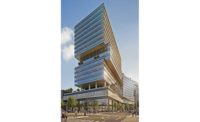Digging Deeper | Airport/Transit
Nashville Airport's $1.4B Revamp Hits the Right Notes

Successfully accelerating expansion projects as passenger numbers continue to grow at Nashville International Airport have helped the Metropolitan Nashville Airport Authority earn the title of ENR Southeast's 2023 Owner of the Year.
Photo by Aerial Innovations
Nashville’s professional music makers know what it takes to turn chaotic cacophony into flowing harmonies. But even they might learn something about synchronicity from BNA Vision, the $1.4-billion expansion program underway at Music City’s international airport.
Named for the Nashville airport code, the collection of bond-funded terminal, garage and other facility projects that launched in 2017 aims to accommodate a sustained double-digit trend in passenger volume that was only briefly stunted by the coronavirus pandemic. In July, fourteen months after the virus all but grounded air travel nationwide, BNA’s average departure counts had surged past 2019 levels, with more than 25,000 passengers boarding outbound flights each day.
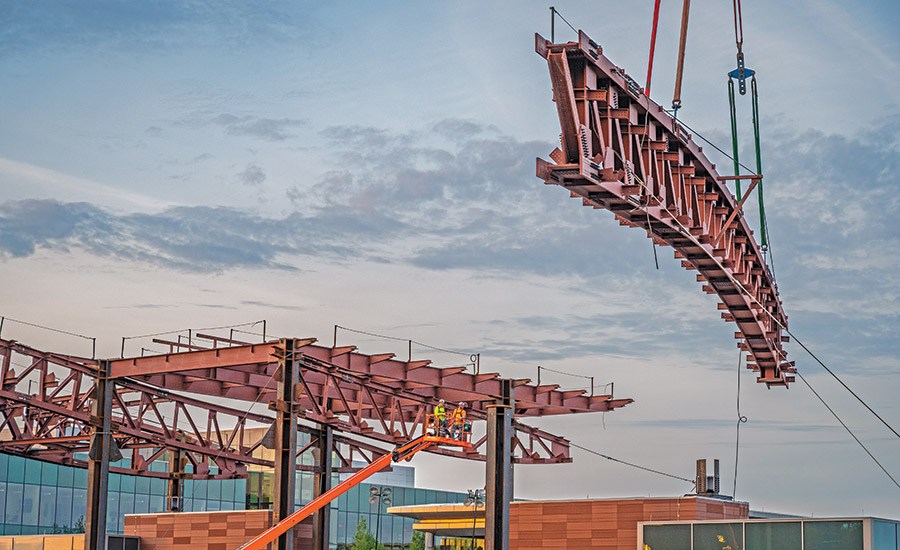
Placing one of the 16 curved spine trusses for the Airwave canopy that will stretch from Terminal Garage 1 across the main access road to the international arrivals facility.
Photo by Matt Good
Traci Holton, vice president for engineering and deputy chief operating officer for the Metropolitan Nashville Airport Authority (MNAA), says that BNA Vision’s original intent was to accommodate the airport’s growth trajectory through 2041.
Recognizing that the new facilities would be needed by 2023, Holton adds, “We had to accelerate things.”
To fast-forward the complex projects by nearly two decades, MNAA adopted progressive design-build delivery, “making each project a building block for another,” Holton says.
For example, one of BNA Vision’s early projects extended the existing main terminal wings by 200,000 sq ft for new ticketing and baggage claim space and created a 115,000-sq-ft, six-gate Concourse D.
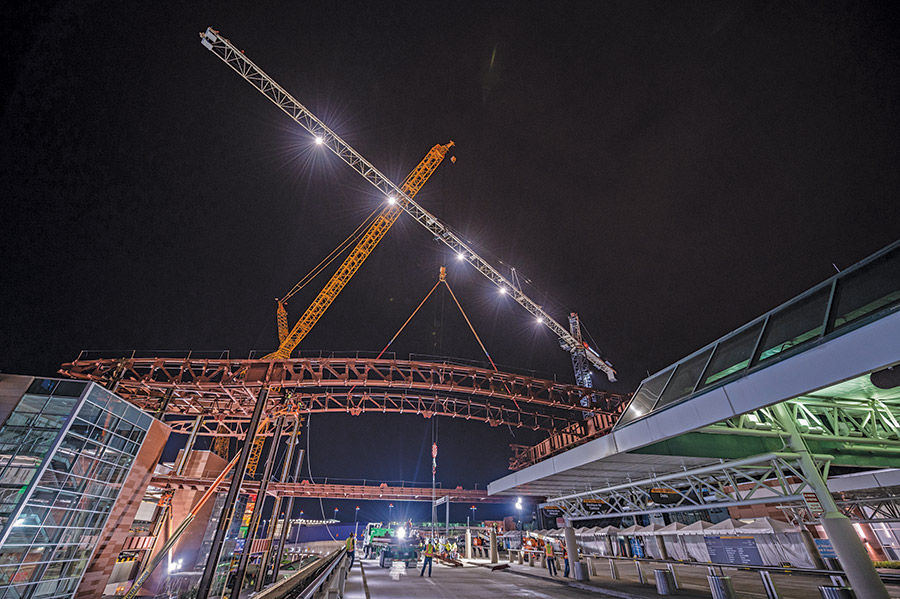
The longest truss for the Airwave is 179 ft long and weighs 281,000 lb. Twenty-four cruciform columns support the trusses, with a suspended 198-ft-long pedestrian bridge crossing the roadway below.
Photo by Matt Good
The three-year effort, led by Hensel Phelps and Fentress Architects and completed in July 2020, allowed BNA’s terminal to be split in two, clearing the building’s central core for the program’s largest component—a $327-million, 440,000-sq-ft multifaceted project that renovates existing space into a marketplace with retail, dining and service amenities and expanded security screening operations. The project also expands the terminal with a new six-gate international arrivals facility (IAF) that will also contain a larger Customs and Border Protection (CBP) processing area.
Callie Hepler, project manager for Hensel Phelps, which again teamed with Fentress for the central terminal/IAF project, explains that the new Concourse D freed up sufficient space for the terminal construction activity to proceed without reducing the overall number of gates. Still, minimizing impacts on the airport’s operations has proven to be an exercise in complex planning.
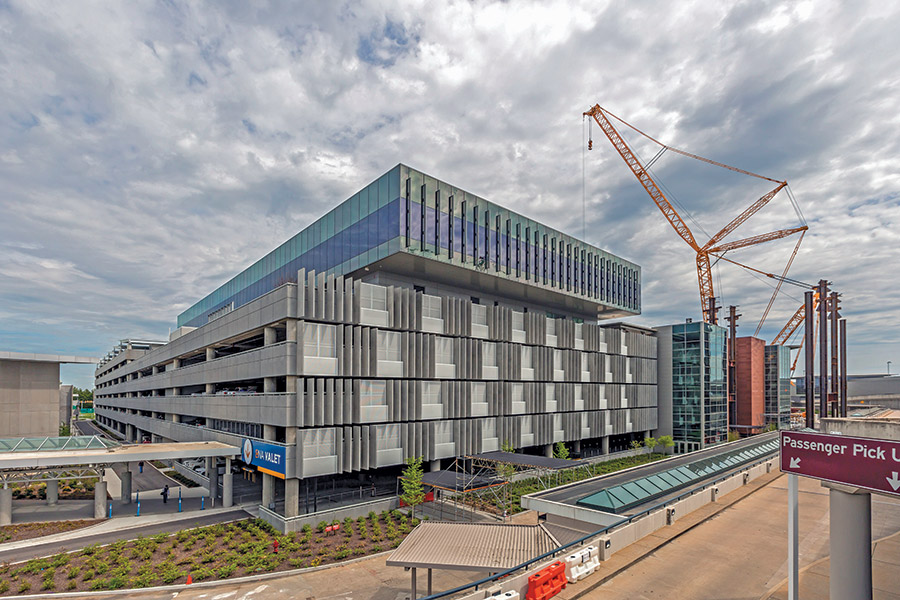
Terminal Garage 1 will be topped with a pedestrian plaza and a two-level 72,000-sq-ft airport administrative center.
Photo courtesy Messer Construction
“Everything that affects the passenger experience had to be considered,” Hepler says. “That included everything from temporarily relocating rental car counters to installing eight escalators to preserve vertical circulation while the central core is being renovated.”
Construction of the IAF began last fall within a footprint safely fenced off from adjacent tarmac traffic. Hensel Phelps excavated approximately 40,000 cu yd of rock from an 18-ft-deep excavation supported by 180 soldier piles. With the IAF’s structural four-level steel frame now rising from 296 deep foundations averaging 25.7 ft in length, demolition for the marketplace renovation has gotten underway.
Overlooking the airfield, the expansive marketplace atrium and IAF will be clad with metal panels and electrochromic glazing that allows the airport to adjust the exterior’s color with time of day and outside lighting conditions. Both projects are set to wrap up by the end of 2023.
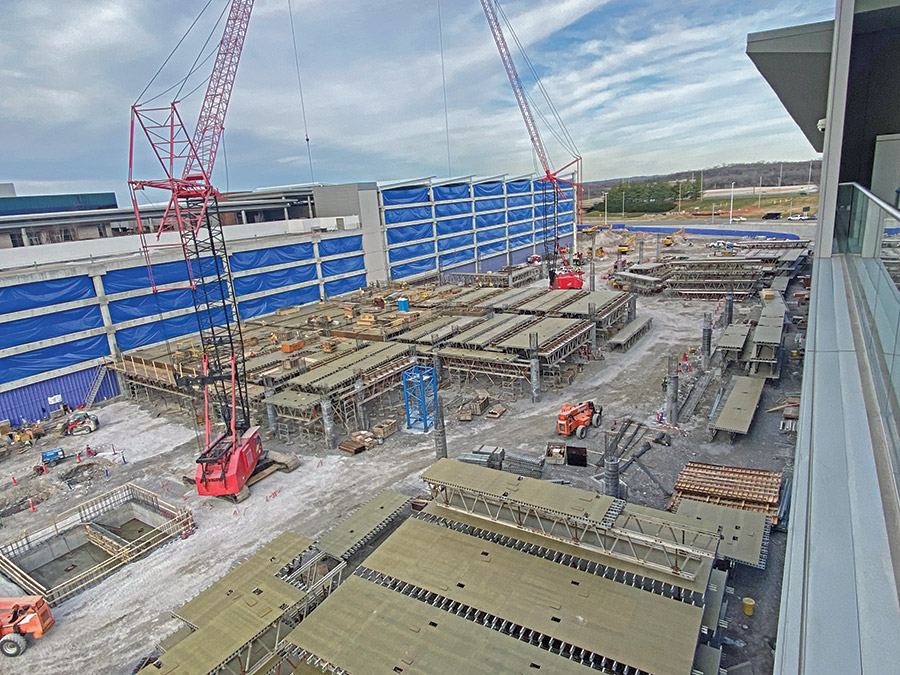
The project includes renovating existing space into a marketplace with retail, dining and service amenities and expanded security screening operations.
Photo courtesy Messer Construction
A construction-style jam session
Meanwhile, a similar “building block” strategy was being applied to expand BNA’s parking facilities, beginning with a six-level, 2,200-space structure completed by JE Dunn in 2018. Eighteen months later, Messer Construction Co. completed a companion cast-in-place post-tensioned structure called Terminal Garage 1 and designed by Moody Nolan. Located directly across from the terminal, the $183-million building provides 3,000 spaces and a double-helix ramp on four levels and is topped with a pedestrian plaza and BNA’s two-level, 72,000-sq-ft administrative center.
Jeff Banta, Messer operations vice president, explains that keeping the garage on schedule was particularly critical because existing administrative office space in the terminal would become part of the new marketplace area. A round-the-clock demolition effort cleared an older three-level garage from the construction site, followed by excavation of 50,000 cu yd of rock. For one part of the cut, Messer brought in rock hammers to reach the required 12-ft-deep foundation pad level.
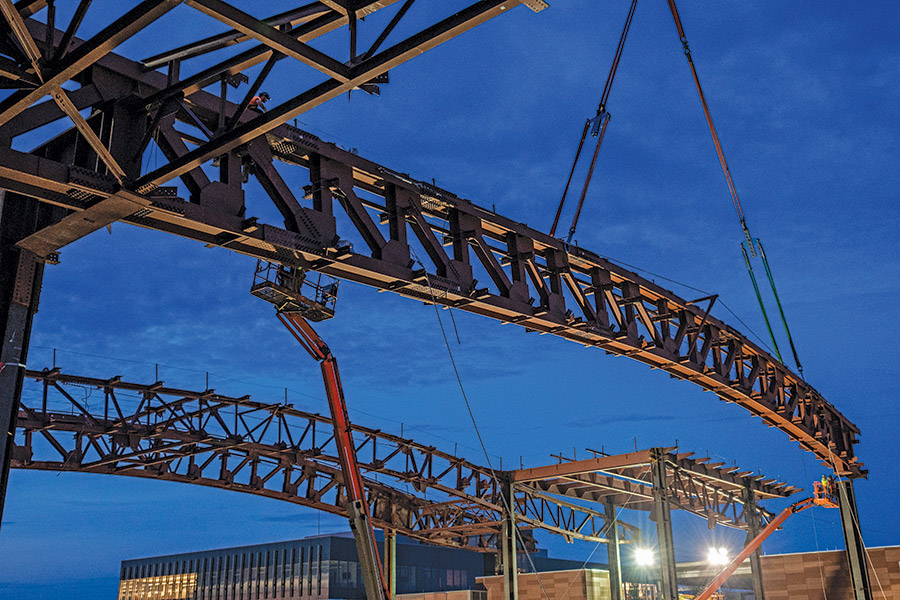
Terminal access roads had to be closed and traffic rerouted on six nights to place steel for the Airwave canopy.
Photo by Matt Good
“We were also very aggressive on concrete, framing and placing an average of 33,000 sq ft each week using up to five pours and multiple crews,” Banta adds. He credits the effort made by Charter Construction of Nashville, saying the project’s turnkey concrete sub “was integral to getting the work done and staying on schedule.”
Messer is now at work on building Terminal Garage 1’s $82-million second phase, a project that adds yet another dimension to the BNA Vision program. Along with adding another 2,800 spaces, the parking structure will be topped with a new 10-story, 292-hotel being developed with Chartwell Hospitality as a public-private partnership. Messer and Chartwell’s general contractor, Crain Construction, are using 3D modeling to coordinate elements such as elevator shaft size and location, Banta says. As with the terminal and IAF, the garage and hotel are scheduled to be complete in late 2023.
Having the owner involved early to coordinate site logistics as well as ... discussing plans have both been really helpful.”
—Callie Hepler, Project Manager, Hensel Phelps Construction
Perhaps the biggest challenge to BNA Vision’s goal of preserving seamless airport operations was construction of the Airwave, a 156,000-sq-ft steel canopy that eventually will stretch from Terminal Garage 1 across the main access road to the end of the IAF.
The structure, designed by Fentress, bridging architect Corgan and structural engineer Magnusson Klemencic Associates, combines 16 curved spine trusses of varying lengths, with the longest being a 179-ft-long element weighing more than 281,000 lb. Twenty-four 19- to 99-ft-long roof cruciform columns support the trusses, with a suspended 198-ft-long pedestrian bridge connecting the garage with the terminal vestibule.
Hoisting the Airwave’s massive elements required Hensel Phelps to enlist a Demag CC 8800 crane, “one of the very few machines in the world that had the lifting and reach capacity we needed,” Hepler says. Each pick required precise positioning of both the crane and the steel element, which took a months-long planning effort that was further complicated when hoisting activity required closure of the terminal’s sole access road.
Hensel Phelps and MNAA scheduled six nights when the road could be shut down completely for up to eight hours while terminal traffic was rerouted through the garages. A team of 65 MNAA staff volunteers were on hand to assist motorists and put a public face on what might otherwise have been a frustrating experience for airport users.
To date, two-thirds of the roof has been set in place, with the remaining section to follow after the IAF tops out in early 2022.
“The coordination work really paid off,” Hepler adds.
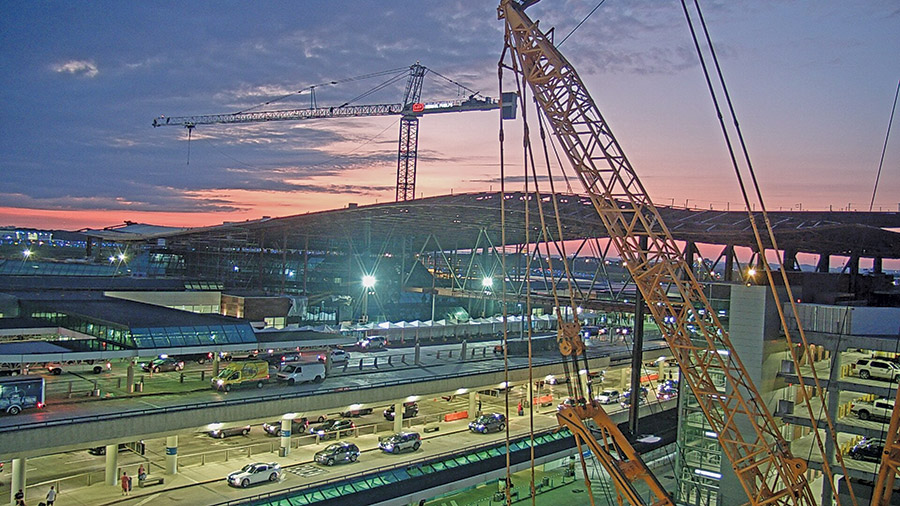
Good communication helped keep the many interrelated parts of the project on schedule.
Photo courtesy metropolitan Nashville Airport Authority
Instant improvisation
One facet of BNA Vision that defied even the most prescient planning was the pandemic and its effects on safety, scheduling and supplies.
“COVID hit at homestretch for the garage,” Banta says. “We never stopped work, though any positive tests required pauses to make sure everyone was safe.”
While the projects have navigated strained supply chains, a supplier’s last-minute inability to provide precast terra-cotta panels for terminal and garage facades forced a quick pivot to an alternative source in Portugal.
“There were no other supply issues, but we are doing more proactive ordering for the garage’s second phase,” Banta says.
Hepler says communication has proven fundamental to keeping BNA Vision’s interrelated moving parts on schedule. Co-locating contractors with MNAA’s engineering staff and weekly multiproject coordination meetings has kept everyone engaged and accessible with each other.
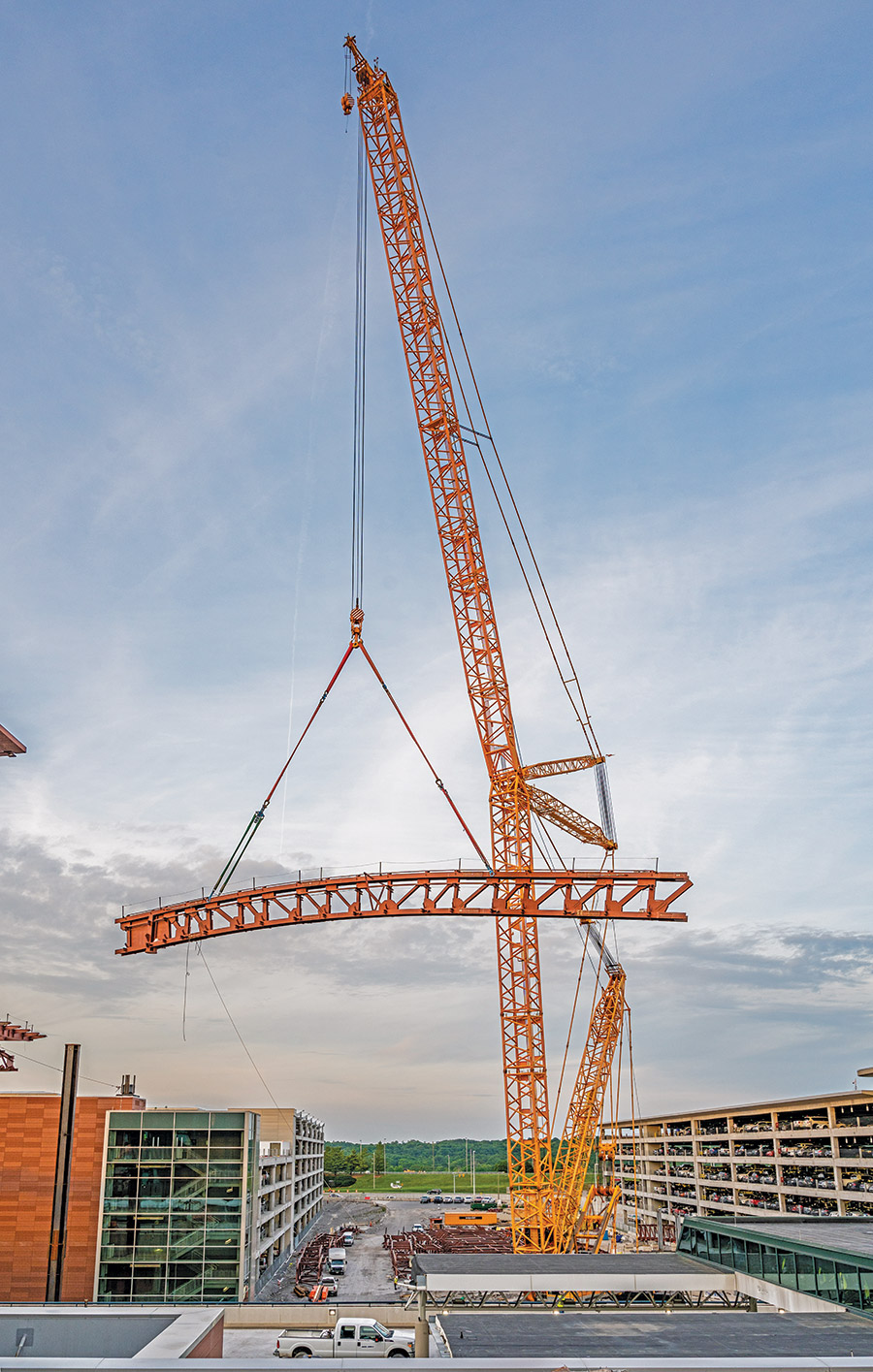
A Demag CC 8800 crane was required to lift the massive elements of the Airwave canopy.
Photo by Matt Good
“Having the owner involved early to coordinate site logistics as well as regularly discussing plans with other contractors have both been really helpful,” she says.
The approach also enabled MNAA to augment the original BNA Vision with what Holton calls a “2.0” suite of additional projects, including an 89,000-sq-ft, eight-gate satellite concourse for narrow-body and regional aircraft. The $75-million project is being built by Holder Construction and is also set for completion in late 2023.
MNAA also recently awarded a $27-million contract to Eutaw Construction for a 750,000-cu-yd mass grading project that will level a 95-ft-deep depression and create 27 acres of space for aircraft taxi lanes and airside facilities to support another future concourse expansion.
“That sets us up for the future extension of Concourse A, part of what we’re calling Beyond Vision,” Holton says. Along with an expansion of the recently completed Concourse D, “these are projects we’ll undertake as we continue to grow.”



